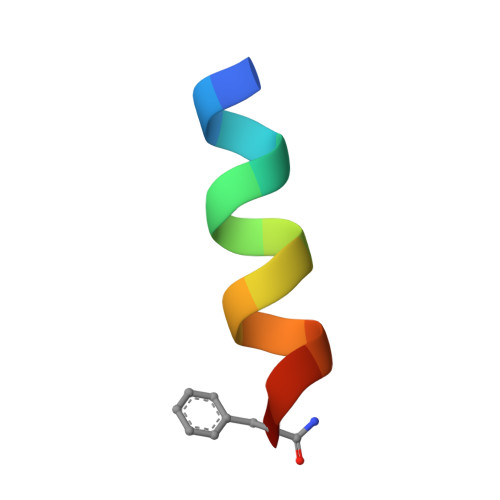Schistocins: Novel antimicrobial peptides encrypted in the Schistosoma mansoni Kunitz Inhibitor SmKI-1.
Santos, B.P.O., Alves, E.S.F., Ferreira, C.S., Ferreira-Silva, A., Goes-Neto, A., Verly, R.M., Liao, L.M., Oliveira, S.C., de Magalhaes, M.T.Q.(2021) Biochim Biophys Acta Gen Subj 1865: 129989-129989
- PubMed: 34389467
- DOI: https://doi.org/10.1016/j.bbagen.2021.129989
- Primary Citation of Related Structures:
7M67, 7M73, 7M77, 7M79 - PubMed Abstract:
Here we describe a new class of cryptides (peptides encrypted within a larger protein) with antimicrobial properties, named schistocins, derived from SmKI-1, a key protein in Shistosoma mansoni survival. This is a multi-functional protein with biotechnological potential usage as a therapeutic molecule in inflammatory diseases and to control schistosomiasis. We used our algorithm enCrypted, to perform an in silico proteolysis of SmKI-1 and a screening for potential antimicrobial activity. The selected peptides were chemically synthesized, tested in vitro and evaluated by both structural (CD, NMR) and biophysical (ITC) studies to access their structure-function relationship. EnCrypted was capable of predicting AMPs in SmKI-1. Our biophysical analyses described a membrane-induced conformational change from random coil-to-α-helix and a peptide-membrane equilibrium for all schistocins. Our structural data allowed us to suggest a well-known mode of peptide-membrane interaction in which electrostatic attraction between the cationic peptides and anionic membranes results in the bilayer disordering. Moreover, the NMR H/D exchange data with the higher entropic contribution observed for the peptide-membrane interaction showed that schistocins have different orientations upon the membrane. This work demonstrate the robustness for using the physicochemical features of predicted peptides in the identification of new bioactive cryptides. Besides, it demonstrates the relevance of combining these analyses with biophysical methods to understand the peptide-membrane affinity and improve further algorithms. Bioprospecting cryptides can be conducted through data mining of protein databases demonstrating the success of our strategy. The peptides-based agents derived from SmKI-1 might have high impact for system-biology and biotechnology.
Organizational Affiliation:
Laboratório de Biofísica de Macromoléculas, Departamento de Bioquímica e Imunologia, Instituto de Ciências Biológicas, Universidade Federal de Minas Gerais, Belo Horizonte, Minas Gerais 31270-901, Brazil; Programa Interunidades de Pós-graduação em Bioinformática, Universidade Federal de Minas Gerais, Belo Horizonte, Minas Gerais 31270-901, Brazil.














